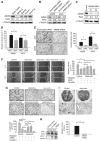Upregulated ankyrin repeat-rich membrane spanning protein contributes to tumour progression in cutaneous melanoma
- PMID: 21343931
- PMCID: PMC3065267
- DOI: 10.1038/bjc.2011.18
Upregulated ankyrin repeat-rich membrane spanning protein contributes to tumour progression in cutaneous melanoma
Abstract
Background: We have previously demonstrated that overexpression of ankyrin repeat-rich membrane spanning (ARMS) protein facilitates melanoma formation via conferring apoptotic resistance. This study aims to investigate whether ARMS contributes to melanoma progression.
Method: Using immunohistochemistry, we graded the expression level of ARMS in 54 cases of primary melanoma and 46 cases of metastatic melanoma. The immunointensity of ARMS was statistically correlated with individual clinicopathological characteristics. By RNA interference, stable melanoma cell clones with ARMS-knockdown were constructed, and were used for in vitro scratch wound, transwell invasion assays, and in vivo lung metastasis experiment.
Results: Stronger immunointensity of ARMS was observed mostly in melanomas with Breslow tumour thickness >1.0 mm (Fisher's exact test, P=0.002) or with nodal metastasis (Fisher's exact test, P=0.026), and was correlated with a worse overall survival in melanoma patients (log-rank test, P=0.04). Depletion of ARMS inhibited migration, invasion, and metastatic potential of melanoma cells in vitro and in vivo. Moreover, ARMS mediated melanoma cell migration and invasion through activation of the extracellular signal-regulated kinase (ERK) kinase (MEK)/ERK signalling pathway.
Conclusion: Ankyrin repeat-rich membrane spanning expression, conjunctly with tumour thickness or ulceration, may serve as a prognostic factor in patients with cutaneous melanoma.
Conflict of interest statement
The authors declare no conflict of interest.
Figures



References
-
- Arevalo JC, Pereira DB, Yano H, Teng KK, Chao MV (2006) Identification of a switch in neurotrophin signaling by selective tyrosine phosphorylation. J Biol Chem 281: 1001–1007 - PubMed
-
- Balch CM, Gershenwald JE, Soong SJ, Thompson JF, Atkins MB, Byrd DR, Buzaid AC, Cochran AJ, Coit DG, Ding S, Eggermont AM, Flaherty KT, Gimotty PA, Kirkwood JM, McMasters KM, Mihm Jr MC, Morton DL, Ross MI, Sober AJ, Sondak VK (2009) Final version of 2009 AJCC melanoma staging and classification. J Clin Oncol 27: 6199–6206 - PMC - PubMed
-
- Balch CM, Soong SJ, Gershenwald JE, Thompson JF, Reintgen DS, Cascinelli N, Urist M, McMasters KM, Ross MI, Kirkwood JM, Atkins MB, Thompson JA, Coit DG, Byrd D, Desmond R, Zhang Y, Liu PY, Lyman GH, Morabito A (2001) Prognostic factors analysis of 17 600 melanoma patients: validation of the American Joint Committee on Cancer Melanoma Staging System. J Clin Oncol 19: 3622–3634 - PubMed
-
- Brocker EB, Magiera H, Herlyn M (1991) Nerve growth and expression of receptors for nerve growth factor in tumors of melanocyte origin. J Invest Dermatol 96: 662–665 - PubMed
Publication types
MeSH terms
Substances
LinkOut - more resources
Full Text Sources
Medical
Miscellaneous

